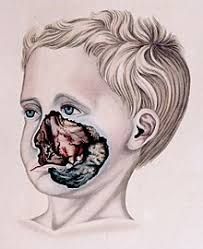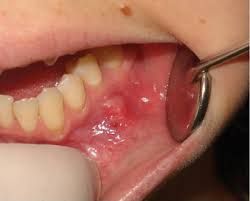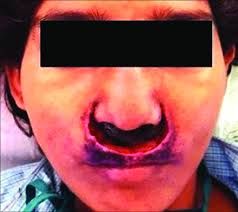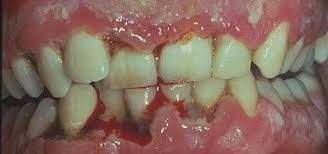Symptoms of Noma Disease
Noma usually begins by a small ulcer in the mouth which translates into necrotizing gingivitis which is painful accompanied by bleeding of the gums and inter-dental papillae.
This continued by rapidly spreading infection to the orofacial tissues leading to edema, gangrenous infection eating off the soft tissues and eventually leading to sloughing.
Many patients die due to sepsis and survivors are left with permanent facial disfigurement in not early treated before reaching the gangrenous stage.
Noma neonatorum on the other hand is a devastating type of Noma infection affecting neonates or newborn babies in impoverished and underdeveloped communities. A gangrenous infection propagates across the oral, nasal and/or anal areas, and is often disastrous and fatal.
Stages of Noma Disease
"The World Health Organization divides noma into five stages: acute necrotizing gingivitis, edema, gangrenous, scarring, and sequelae."Source
Warning signs of Noma Infection
Before noma sets in as a disease, there may be simple inflammation of the gums: that is inflammation and reddening of the gums, which in turn bleed profusely when touched or during brushing of the teeth. The WHO advised the use of disinfectant mouthwash and if not available, a warm, salted water that has been boiled can be used.
Furthermore, highly nutritive diet, vitamins supplement and patient education are highly instrumental to preventing the propagation of Noma disesase.
Stage I: Acute Necrotizing Gingivitis
This is the onset stage of noma. The gums are inflamed making them to observed as red or reddish-purple colour appearance and bleed spontaneously. The child has fetid breath and may drool saliva continuously.
Painful ulceration of the gums is observed. The patient is malnourished and has been recently degraded with an infectious disease, such as measles or chickenpox, they are at more risk for developing noma due to the breakdown of the immune system.
Fever attack maybe observed at this phase of the disease progression and may persist. Appropriate management and treatment at this stage can stop the disease and prevent further complications.
ByStage II: Edema
This stage commences the acute phase of noma. The serious indication(telltale signs) is facial swelling of the lips, cheeks, eyes, and other soft tissues of the face.
Ulceration of the gums becomes aggressive at this stage and spread to the cavities of the orofacial structures.
The patient may feel uneasy due to pain in their mouth. Other symptoms during this stage include fever, drooling, fetid breath, lymphadenopathy (swollen lymph nodes which is tender and palpable), difficulty in eating. Progression of the disease can be put to a halt with early counter management and appropriate treatment.
Stage III: Gangrene
This phase onwards and subsequent stage, Noma sequelae will inevitably set in, though the disesase can still be treated and as such the earlier the detection of Noma the better the treatment.
This stage seems more deadly and devastating because the infection wears off and eats away the soft tissue of the patient's face. The gangrene may strike the cheeks, lips, nose, mouth, and nasal and oral cavities of the patient.
Dead tissue sloughs and drop away over time, leaving holes and cavities in the face and the soft tissue, possibly leading to the exposure of bones and teeth. The patient becomes apathetic, has little or no appetite, and has greater difficulty eating and mastication.
Last but not least, at this stage there is a high risk of sepsis which eventually lead to death.
Stage IV: Scarring
The acute stage of the disease is completely over by scarring, but the patient's life is still hanging in the balance making it to be at risk and treatment is still recommended. This stage lasts one to two weeks. The patient may experience difficulty moving/opening the jaw known as trismus, scars will show up and form, and any exposed teeth may set in wrong place and have bad appearance.
Stage V: Sequelae
This is the end stage of the disease, but aftermath and consequences from the gangrenous and scarring stages remain. Tissue may be missing due to sloughing, teeth may still be exposed, and the face is disfigured.
The patient may have difficult moment in eating, drinking, and speaking. Teeth seems drifted and showed up in wrong position. Drooling may still be a problem further accompanied with opening/closing the jaw. Reconstructive orofacial surgery is a viable option at this phase.
Social reintegration with community education and outreach programmes is also very important to prevent stigma and social isolation on the part of the survivors of Noma.
That's all as regards this write-up on Noma disesase of the orofacial tissues. More would be greatly revealed and further discussed in the subsequent posts. Thanks for the attention given.
Happy Blogging and Reading 💥🦷🦷🦷🦷
Video from Archana Dubey YouTuber




Telegram and Whatsapp